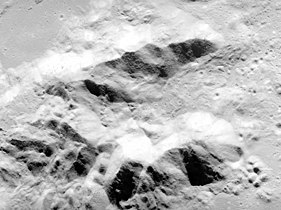
Aryabhata, named after Indian astronomer Aryabhata, is the remnant of a lunar impact crater located in the eastern Mare Tranquillitatis. The crater has been almost submerged by lava-flow, and now only an arc-shaped ridge formed from the eastern half of the rim remains above the lunar mare. This crater was previously identified as Maskelyne E before being named by the IAU in 1979. Maskelyne itself is to the southwest.

Zwicky is a lunar impact crater that is located on the far side of the Moon. It lies to the west of the crater Aitken, and is attached to the western rim of Vertregt. Attached to the northern end of Zwicky is Heaviside. Zwicky is a considerably eroded formation with an irregular rim and interior. Portions of the southern rim still survive, but the remainder has been almost completely eradicated.
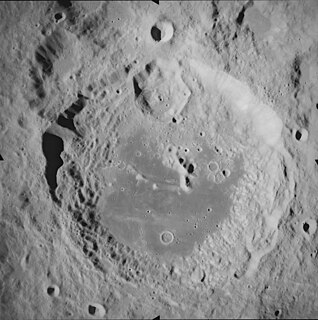
Aitken is a large lunar impact crater that lies on the far side of the Moon, named for Robert Grant Aitken, an American astronomer specializing in binary stellar systems. It is located to the southeast of the crater Heaviside, and north of the unusual formation Van de Graaff. Attached to the southwest rim is Vertregt. To the southeast is the smaller Bergstrand.

Carrel is a small lunar crater on the Mare Tranquillitatis. It has a somewhat distorted appearance, having a slight protruding bulge in the northwest rim. The interior is somewhat irregular, with ridges and some slumped material. This crater lies across a ridge in the surface of the mare.
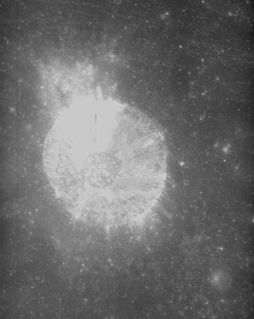
Cauchy is a small lunar impact crater on the eastern Mare Tranquillitatis. It was named after French mathematician Augustin-Louis Cauchy. It is circular and symmetric, with a small interior floor at the midpoint of the sloping inner walls. Due to the high albedo of this bowl-shaped formation, it is particularly prominent at full Moon.

Proclus is a young lunar impact crater located to the west of the Mare Crisium, on the east shore of the Palus Somni. Its diameter is 27 km. It was named after 5th century Greek mathematician, astronomer and philosopher Proclus. It lies to the south of the prominent, terraced crater Macrobius, and west-northwest of the lava-flooded Yerkes.
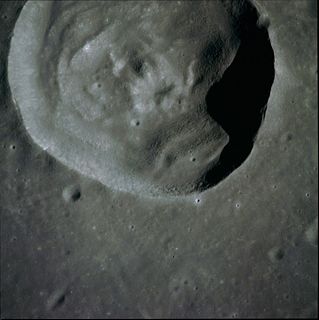
Maskelyne is a solitary lunar impact crater that lies in the southeast part of the Mare Tranquillitatis. Its diameter is 22 km. It was named after British astronomer Nevil Maskelyne. The outer rim has a somewhat polygonal shape, although it is generally circular. The inner walls are terraced and there is a low central rise at the midpoint of the floor.
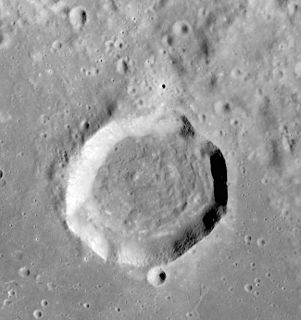
Vitruvius is a small lunar impact crater that lies on the northern edge of the Mare Tranquillitatis. To the east is the crater Gardner, and to the northeast is Fabbroni. To the north-northwest is the elongated Mons Vitruvius mountain, and beyond is the valley where the Apollo 17 mission landed.

Gagarin is a large lunar impact crater that is located in the southern hemisphere on the far side of the Moon. To the southwest is the crater Pavlov and to the northeast lies Keeler. Closer to the rim are the craters Levi-Civita to the southwest, and Beijerinck to the north-northeast. Isaev lies entirely within the northwest rim of Gagarin. In contrast with the floor of Gagarin, Isaev has a floor with a somewhat low albedo.

Atwood is a small earth moon impact crater that is located on the Mare Fecunditatis, to the northwest of the prominent crater Langrenus. It forms a triple-crater formation with Naonobu attached to the north rim and Bilharz near the west rim.

Firmicus is a lunar impact crater that lies in the eastern part of the Moon's near side, so that from Earth it appears oval in shape due to foreshortening. It is, however, very nearly circular. The crater is located to the west of the Mare Undarum, and northeast of the similar-sized crater Apollonius. To the north of Firmicus are the craters van Albada and Auzout. Attached to its northwest rim is the Lacus Perseverantiae, a miniature lunar mare.
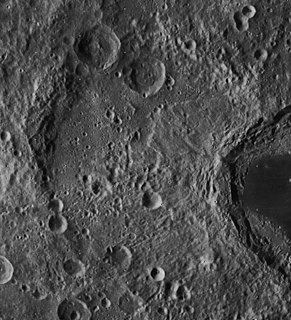
Fermi is a large lunar impact crater of the category named a walled plain. It was named after Italian-American physicist and Nobel laureate Enrico Fermi. It lies on the far side of the Moon and can not be viewed from the Earth. Thus this feature must be viewed from an orbiting spacecraft.

Pasteur is a large lunar impact crater, approximately 233 kilometers in diameter, belonging to the category termed a walled plain. It was named after French chemist and microbiologist Louis Pasteur. It lies on the far side of the Moon as seen from the Earth, just beyond the eastern limb. The vicinity of this crater is occasionally brought into view from Earth due to librations, although not much detail can be seen.

La Pérouse is a lunar impact crater that is located near the eastern limb of the Moon. It lies northwest of the larger crater Ansgarius, and to the east of Kapteyn. This crater appears foreshortened due to its location, but the rim is nearly circular when viewed from orbit.

Mons Hadley is a massif in the northern portion of the Montes Apenninus, a range in the northern hemisphere of the Moon. It has a height of 4.2 km (14,000 ft) above the adjacent plain and a maximum diameter of 25 km at the base.

Ibn Firnas is a lunar impact crater on the far side of the Moon. In 1976 it was named after Abbas Ibn Firnas, a polymath from Andalucia who, in the 9th century, devised a chain of rings that could be used to simulate the motions of the planets and stars.

Sklodowska (Skłodowska) is a large lunar impact crater that is located on the far side of the Moon. It lies just past the southeastern limb, and can sometimes be viewed from Earth under favorable conditions of libration and illumination. The crater is located to the northeast of the older walled plain Curie, and to the southwest of Pasteur, another walled plain.

Necho is a lunar impact crater on the far side of the Moon, and therefore cannot be seen directly from the Earth. It lies to the northeast of the larger crater Langemak, about a crater diameter to the south-southwest of Bečvář and further east is Love.

Patsaev is a lunar impact crater that lies on the far side of the Moon, to the northeast of the prominent crater Tsiolkovskiy. To the northwest is the smaller crater Lander.

Planté is a lunar crater that is situated near the eastern inner wall of the much larger crater Keeler. Just to the east, attached to the exterior of Keeler, is the large crater Heaviside. Planté is located on the far side of the Moon and cannot be viewed directly from the Earth.




